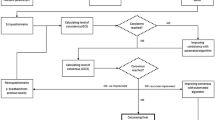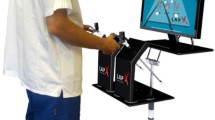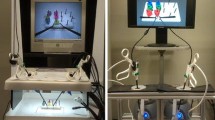Abstract
Background
Virtual reality (VR) laparoscopic simulators have been around for more than 10 years and have proven to be cost- and time-effective in laparoscopic skills training. However, most simulators are, in our experience, considered less interesting by residents and are often poorly accessible. Consequently, these devices are rarely used in actual training. In an effort to make a low-cost and more attractive simulator, a custom-made Nintendo Wii game was developed. This game could ultimately be used to train the same basic skills as VR laparoscopic simulators ought to. Before such a video game can be implemented into a surgical training program, it has to be validated according to international standards.
Methods
The main goal of this study was to test construct and concurrent validity of the controls of a prototype of the game. In this study, the basic laparoscopic skills of experts (surgeons, urologists, and gynecologists, n = 15) were compared to those of complete novices (internists, n = 15) using the Wii Laparoscopy (construct validity). Scores were also compared to the Fundamentals of Laparoscopy (FLS) Peg Transfer test, an already established assessment method for measuring basic laparoscopic skills (concurrent validity).
Results
Results showed that experts were 111 % faster (P = 0.001) on the Wii Laparoscopy task than novices. Also, scores of the FLS Peg Transfer test and the Wii Laparoscopy showed a significant, high correlation (r = 0.812, P < 0.001).
Conclusions
The prototype setup of the Wii Laparoscopy possesses solid construct and concurrent validity.



Similar content being viewed by others
References
Cooper JB, Taqueti VR (2004) A brief history of the development of mannequin simulators for clinical education and training. Qual Saf Health Care 13(Suppl 1):i11–i18
Aggarwal R, Ward J, Balasundaram I, Sains P, Athanasiou T, Darzi A (2007) Proving the effectiveness of virtual reality simulation for training in laparoscopic surgery. Ann Surg 246(5):771–779
Ahlberg G, Enochsson L, Gallagher AG et al (2007) Proficiency-based virtual reality training significantly reduces the error rate for residents during their first 10 laparoscopic cholecystectomies. Am J Surg 193(6):797–804
Grantcharov TP, Kristiansen VB, Bendix J, Bardram L, Rosenberg J, Funch-Jensen P (2004) Randomized clinical trial of virtual reality simulation for laparoscopic skills training. Br J Surg 91(2):146–150
Larsen CR, Oestergaard J, Ottesen BS, Soerensen JL (2012) The efficacy of virtual reality simulation training in laparoscopy: a systematic review of randomized trials. Acta Obstet Gynecol Scand 91(9):1015–1028
Schlickum MK, Hedman L, Enochsson L, Kjellin A, Felländer-Tsai L (2009) Systematic video game training in surgical novices improves performance in virtual reality endoscopic surgical simulators: a prospective randomized study. World J Surg 33(11):2360–2367
Rosenthal R, Geuss S, Dell-Kuster S, Schäfer J, Hahnloser D, Demartines N (2011) Video gaming in children improves performance on a virtual reality trainer but does not yet make a laparoscopic surgeon. Surg Innov 18(2):160–170
Badurdeen S, Abdul-Samad O, Story G, Wilson C, Down S, Harris A (2010) Nintendo Wii video-gaming ability predicts laparoscopic skill. Surg Endosc 24(8):1824–1828
Bokhari R, Bollman-McGregor J, Kahoi K, Smith M, Feinstein A, Ferrara J (2010) Design, development, and validation of a take-home simulator for fundamental laparoscopic skills: using Nintendo Wii for surgical training. Am Surg 76(6):583–586
Mann BD, Eidelson BM, Fukuchi SG, Nissman SA, Robertson S, Jardines L (2002) The development of an interactive game-based tool for learning surgical management algorithms via computer. Am J Surg 183(3):305–308
Carter FJ, Schijven MP, Aggarwal R et al (2005) Consensus guidelines for validation of virtual reality surgical simulators. Surg Endosc 19(12):1523–1532
Schijven MP, Jakimowicz JJ (2005) Validation of virtual reality simulators: key to the successful integration of a novel teaching technology into minimal access surgery. Minim Invasive Ther Allied Technol 14(4):244–246
Zhang A, Hünerbein M, Dai Y, Schlag PM, Beller S (2008) Construct validity testing of a laparoscopic surgery simulator (Lap Mentor): evaluation of surgical skill with a virtual laparoscopic training simulator. Surg Endosc 22(6):1440–1444
Van Dongen KW, Tournoij E, van der Zee DC, Schijven MP, Broeders IA (2007) Construct validity of the LapSim: can the LapSim virtual reality simulator distinguish between novices and experts? Surg Endosc 21(8):1413–1417
Schijven M, Jakimowicz J (2003) Construct validity: experts and novices performing on the Xitact LS500 laparoscopy simulator. Surg Endosc 17(5):803–810
Madan AK, Frantzides CT, Park WC, Tebbit CL, Kumari NV, O’Leary PJ (2005) Predicting baseline laparoscopic surgery skills. Surg Endosc 19(1):101–104
Rosser JC Jr, Lynch PJ, Cuddihy L, Gentile DA, Klonsky J, Merrell R (2007) The impact of video games on training surgeons in the 21st century. Arch Surg 142(2):181–186
Thorson CM, Kelly JP, Forse RA, Turaga KK (2011) Can we continue to ignore gender differences in performance on simulation trainers? J Laparoendosc Adv Surg Tech A 21(4):329–333
Society of American Gastrointestinal and Endoscopic Surgeons (2008) FLS trainer box. http://www.flsprogram.org/testing-information/trainer-box/. Accessed Jun 2012
Fried GM (2008) FLS assessment of competency using simulated laparoscopic tasks. J Gastrointest Surg 12(2):210–212
Ritter EM, Scott DJ (2007) Design of a proficiency-based skills training curriculum for the fundamentals of laparoscopic surgery. Surg Innov 14(2):107–112
Fried GM, Feldman LS, Vassiliou MC (2004) Proving the value of simulation in laparoscopic surgery. Ann Surg 240(3):518–525
Peters JH, Fried GM, Swanstrom LL (2004) Development and validation of a comprehensive program of education and assessment of the basic fundamentals of laparoscopic surgery. Surgery 135(1):21–27
Fraser SA, Feldman LS, Stanbridge D, Fried GM (2005) Characterizing the learning curve for a basic laparoscopic drill. Surg Endosc 19(12):1572–1578
Ritter EM, Kindelan TW, Michael C, Pimentel EA, Bowyer MW (2007) Concurrent validity of augmented reality metrics applied to the fundamentals of laparoscopic surgery (FLS). Surg Endosc 21(8):1441–1445
Field A (2005) Discovering statistics using SPSS, 2nd edn. SAGE Publications, London
Chmarra MK, Grimbergen CA, Jansen FW, Dankelman J (2010) How to objectively classify residents based on their psychomotor laparoscopic skills? Minim Invasive Ther Allied Technol 19(1):2–11
McCartan DP, Fleming FJ, Hill AD (2012) Patient and surgeon factors are associated with the use of laparoscopy in appendicitis. Colorectal Dis 14(2):243–249
Acknowledgments
The authors would like to thank H. Groen, Department of Epidemiology, University of Groningen, University Medical Center Groningen, for checking our statistical analyses.
Disclosures
M. B. Jalink, J. Goris, E. Heineman J. P. E. N. Pierie, and H. O. ten Cate Hoedemaker have no conflicts of interest or financial ties to disclose. The authors were given a prototype version of the Wii Laparoscopy video game from its developer, Cutting Edge B.V., to use in this research. No additional Grants were received to fund this research.
Author information
Authors and Affiliations
Corresponding author
Rights and permissions
About this article
Cite this article
Jalink, M.B., Goris, J., Heineman, E. et al. Construct and concurrent validity of a Nintendo Wii video game made for training basic laparoscopic skills. Surg Endosc 28, 537–542 (2014). https://doi.org/10.1007/s00464-013-3199-6
Received:
Accepted:
Published:
Issue Date:
DOI: https://doi.org/10.1007/s00464-013-3199-6




